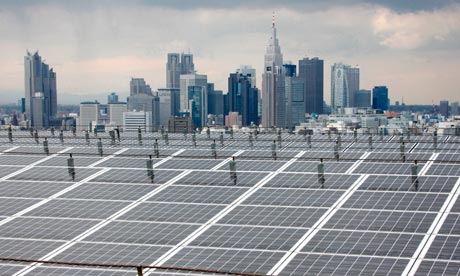
Japan to scrap nuclear power for renewables and conservation
The prime minister says Japan must 'start from scratch' and Japan will scrap a plan to obtain half of its electricity from nuclear powerand will instead promote renewable energy as a result of its nuclear crisis, the prime minister said Tuesday. Naoto Kan said Japan needs to "start from scratch" on its long-termenergy policy after the Fukushima Dai-ichi nuclear power plant was heavily damaged by a 11 March earthquake and tsunami and began leaking radiation.
Japan's nuclear plants supplied about 30% of the country's electricity, and the government had planned to raise that to 50%.
Kan told a news conference that nuclear and fossil fuel used to be the pillars of Japanese energy policy but now it will add two more – renewable energy such as solar, wind and biomass, and an increased focus on conservation.
"We will thoroughly ensure safety for nuclear power generation and make efforts to further promote renewable energy," an area where Japan has lagged behind Europe and the US, he said.
On Monday a landmark report by the UN's climate science body, the IPCC, said that renewable energy could account for 80% of the world's energy supply by 2050 – but only if governments pursue the right policies.
Kan also said he would take a pay cut beginning in June until the Fukushima nuclear crisis is resolved to take responsibility as part of the government that has promoted nuclear energy. He didn't specify how much of a pay cut he would take.
The operator of the stricken power plant, Tokyo Electric Power Co, has been struggling for nearly two months to restore critical cooling systems that were knocked out by the disaster. Some 80,000 people living within a 12-mile radius of the plant were evacuated from their homes on 12 March, with many living in gymnasiums.
On Tuesday, about 100 evacuees were allowed into that exclusion zone briefly to gather belongings from their homes.
The excursion marked the first time the government has felt confident enough in the safety of the area to allow even short trips there. Residents have been pushing hard for weeks for permission to check up on their homes.
The evacuees boarded chartered government buses for the two-hour visit.
They were provided with protective suits, goggles and face masks to wear while in the zone, and were issued plastic bags to put their belongings in. They were also given dosimeters to monitor radiation levels and walkie-talkies.
All were to be screened for radiation contamination after leaving the zone.
More visits are planned, but residents fear they may never be able to return for good.
Many had been secretly sneaking back into the zone during the day, but the government – concerned over safety and the possibility of theft – began enforcing stricter roadblocks and imposing fines on 22 April.
The official visits were seen as a compromise that took both safety and the wishes of the residents into consideration.
The government and TEPCO in April projected that bringing the plant to a cold shutdown could take six to nine months and residents might be able to return to resume their lives. But they admit that timing is a best-case scenario.
On Monday, another utility, Chubu Electric Power Co, agreed to shutter three reactors at a coastal power plant while it builds a seawall and improves other tsunami defenses there.
Kan requested the temporary shutdown at the Hamaoka plant amid predictions an earthquake of magnitude 8.0 or higher could strike the central Japanese region within 30 years. The government's decision came after evaluating Japan's 54 reactors for quake and tsunami vulnerability after the 11 March disasters. The Hamaoka facility sits above a major fault line and has long been considered Japan's riskiest nuclear power plant.
Kan said Japan will have to compile Japan's new energy policy in a report for submission to the International Atomic Energy Agency in June. He didn't give any numerical estimates for each source of energy in the new policy.abandon its plan to obtain half its energy from atomic power
No comments:
Post a Comment